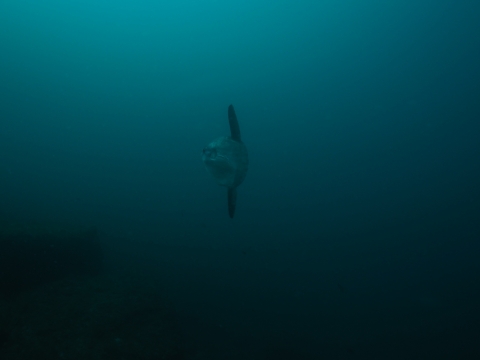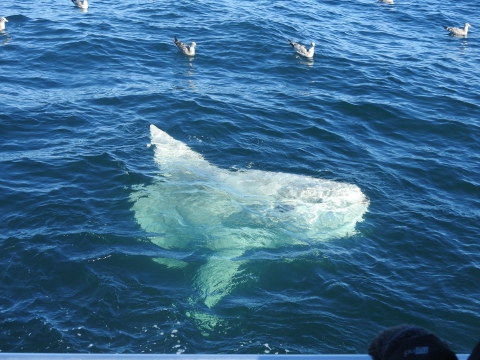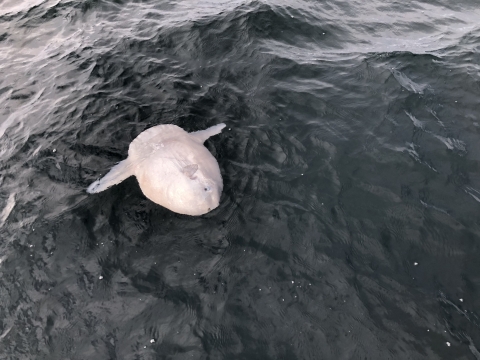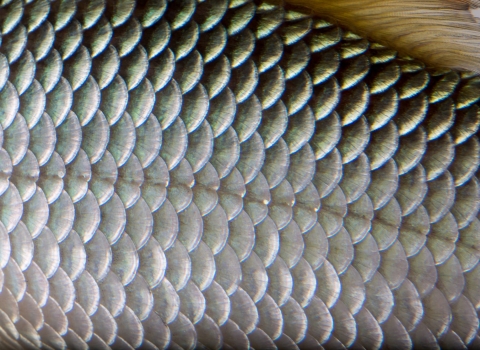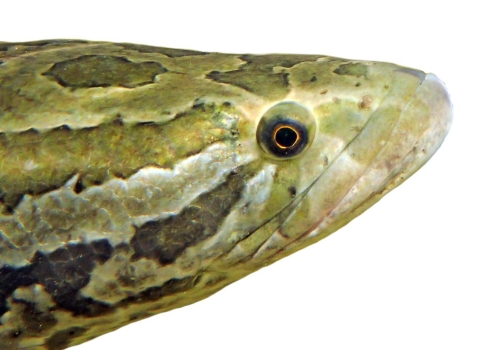When we think about the biggest fishes in the ocean, we might often first think about the massive apex predators like marlin, bluefin tuna, or great white sharks—sleek speedsters and unparalleled hunters, speeding across the sea in search of their next meal! But if size is what you’re looking for, then you’d better put on your swimsuit, rub on some reef-friendly suntan lotion, and turn your eyes to the tailless, oversized dinner plate that’s relaxing just under the surface and soaking up the rays.
The ocean sunfishes, or molas, are truly unique open-ocean fish with the distinction of being the largest bony fish on Earth. With some reaching weights heavier than a rhino, these gentle giants include five sunfish species native to warm tropical and temperate waters around the world. In fact, the largest specimen yet recorded was discovered by researchers surveying the Azores in the north Atlantic who found the floating carcass of a 11.8 foot, 6,036 pound bump-head sunfish (Mola alexandrini) that was likely killed by a ship strike.
Their distinctive shape— circular flat body, small open mouth, large eyes, and seeming lack of a tail—is quite difficult to mistake for anything else in the ocean. Their huge and elongated dorsal and ventral fins can make them as tall as they are long, if not taller! While their clavus, the rounded pseudo-tail that has replaced the mola’s tailfin, can be moved somewhat and used as a rudder, the large vertical fins are flapped like wings to propel the mola through the water. Similar to their closest relatives, the pufferfish and porcupine fish, their anatomy is sturdy, bulky, and less flexible than other fish.
“They have a lot of cranial fusion, so many bones in their head are fused to look more like a human skull... fish have so many bones and they also have their whole spine fused, and very few vertebral centra. So they're not wagging their bodies. They're wagging their fins [when they swim].”
Larval molas are strikingly similar to, as Dr. Thys puts it, “little pin cushions with fins. They're completely adorable. And they give away their ancestry with their individual development.”
Molas are fast-growing, able to tolerate a huge range of water temperatures, and can be found further north than the Arctic circle and further south than Cape Town, South Africa. As befits their unique appearance, they also fill a very unique ecological niche. While juvenile molas have tiny teeth and prey on everything from squid to hake to bottom-dwelling tunicates, adult fish famously eat primarily jellyfish and other gelatinous organisms that have few other predators.
Jelly-Fueled Athletes
In stark contrast to the way they’re often seen slowly drifting near the surface, molas are actually some seriously efficient swimmers. Tagged specimens have been recorded traveling nearly 20 miles in a single day, reaching speeds of about 20 feet per second, and making lengthy migrations from Taiwan to New Caledonia. Most surprising of all, they’ve been observed making stunning leaps out of the water, launching themselves 10 feet or more into the air.
“They may look like they're just some ne'er-do-well, lying around, you know, sucking down jellies at the surface. But they are hiding quite an active agenda— they can dive to 1000 meters, up to 40 times a day.”
Sunfish musculature reflects this, with most of their muscle mass being clustered around their dorsal and ventral fins rather than their rudder.
Relax Up High to Dive Down Low
These deep dives also help explain the sun-soaking behavior that gives them their name, where they lie mostly motionless just below the surface.
“They're like a big solar panel. So the deeper they dive in, the colder they get, the more time they spend up at the surface warming up… that can serve a multiplicity of purposes: they can warm their bodies up for future dives, they can also expose their skin to UV light and bake off parasites. They're rather infamous for having a ton of parasites.”
Indeed, the mola’s legendary parasite problems are so significant that even their parasites have parasites! Someone get Leonardo DiCaprio on the phone, there’s an Inception sequel in the making here. But for other traveling animals on the ocean surface, a basking mola and its preponderance of parasites represents a show too good to miss. While larval fish and species of cleaner fish often take shelter underneath the mola and dine on its smaller parasites, molas often rely on seabirds to land nearby and dig larger parasites out of their surface-facing side to eat. If your first thought is something akin to a scene from some horror movie involving a power drill and a lot of squishy bits, you aren’t too far off.
“Birds are not the best masseuse. They're not the hygienist you would opt for. And if given the opportunity, they will poke the Mola's eyes out in a second, in a heartbeat. So, the molas have this muscle where they can pull their eyes deep into their sockets and protect their eyes. And the seagulls…they're in it just to get that tasty morsel. And if they take a bit of the poor sunfish's skin with it, doesn't matter.”
As if molas sitting at the surface weren’t being inconvenienced enough, their large size and distinct lack of stealth make them an extremely tempting target for any large predators in their vicinity. While their extremely thick skin offers them some protection, Dr. Thys’ comparison of them to a tough-to-crack coconut is quite apt. Orca, various sharks, and sea lions are all known to regularly attack sunfish, though sea lions can often have a harder time getting through their skin. However, Dr. Thys speaks of a macabre form of play that’s been observed in sea lion herds preying upon molas:
“They play ultimate frisbee with them. They rip off the dorsal and anal fins, fashion them into these little round disks and toss them in between each other…they can get into the hide, they'll eat the sunfish, but if they get tired with it, then they'll just kind of toss it around like a Frisbee.”
While molas have little in the way of counterattacking tactics when facing predators, the sight of free-swimming molas with noticeable shark bite scars may suggest that they can be agile enough to escape sometimes.
Don’t Disturb the Dragon
Human activity also represents a threat to sunfish worldwide. Interest in them as a food fish is somewhat limited to areas such as Taiwan, Japan, and the Philippines, where their intestines are eaten as a dish known as “Dragon intestine”. However, their huge size, broad profile, and massive ranges make them a common bycatch in drifting gillnet fisheries found in, for example, the Mediterranean. Certain locations known for their concentrations of molas near the surface also present significant disturbances and danger from groups of human sight-seeing, explains Dr. Thys.
“You see this in many places with whale sharks, with orca. You know, too many divers harassing the animals. These islands off Bali are a big hotspot for diving…You get way too many divers in the water, and they're just pawing at the fish and flashing their lights. And the reason they come to those particular areas is to get cleaned of their parasites. If they're getting harassed, then they can't get cleaned. And that leads to secondary infections. And it can lead to their death.”
It can also discourage them from coming back to that dive site.
If you’re lucky enough to encounter a gorgeous mola in the water (like this author did while fishing in the Gulf of Mexico), just watch passively and let them do their thing! If the mola can safely relax and have its parasites removed, you’ll be able to see a spectacular show as cleaner fish and birds have their feast.
Why Change a Good Thing?
Given the extremely unorthodox appearance, physiology, and diet of ocean sunfish, it can be easy to look at them as an evolutionary oddity that might not have a ton of staying power as a species. However, Dr. Thys offers some counterpoints.
“I think these fish have many, many characteristics to suit them well for longevity in this fast-changing world, most definitely. For one, they have massive range...the more places you exist, the more likely you are to persist...they have great thermal range and can tolerate today's fast warming ocean. Some of our preliminary data shows that they can tolerate hypoxic conditions for short period of time. They produce a ton of young; that's a good strategy in a fast-changing ocean…In some areas where we've pulled out all the food fish, the low energy life forms like jellies have moved in and taken up residence…So, we need to keep all our jelly eaters intact. The molas are an important component of, of that whole gelatinous zooplankton ecosystem. And they're just so darn endearing that I think people are enchanted by them.”
We’re inclined to agree! So get out there, soak up the sun, and enjoy all the fish—especially some of the largest, roundest, and weirdest fish of the bunch.
More Mola
Catch more info on Molas with guest Dr. Tierney Thys on our award-winning podcast Fish of the Week! Apple Podcasts I FWS.gov
Get out there and live with, live from, discover and enjoy all the fish!



